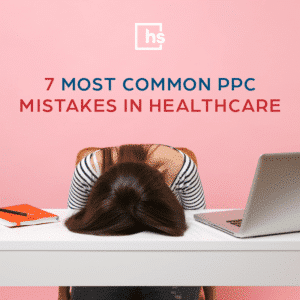
Paid search is a powerful tool for healthcare marketers. Unlike organic SEO, paid search advertising (also known as pay-per-click or PPC) allows healthcare brands to attract patients and communities by instantly bringing a site to the top of the search results.
So, why is the pay-off for PPC falling short for so many?
This is a good question and one that we often receive here at Healthcare Success.
Tapping into our digital team of experts, they lamented that many healthcare brands share the same PPC challenges.
Garrick Gaffney, the Senior Digital Strategist at Healthcare Success, explains it this way: “It’s really twofold when it comes to PPC programs. In all the years of doing this, we see clients wasting their investment and not getting the proper attention to their accounts.”
How are your PPC efforts?
If you’re wondering whether you are wasting your money on paid search campaigns, you probably are. Not to ruin the punchline, but it’s a little like walking up to a high-stakes poker table: there’s a potential for big gains but also big losses. Anyone can throw money into the PPC game; the hard part is winning.
Before we get into how to avoid the most common PPC mistakes, let’s first delineate the two main PPC tactics: search and display advertising. You can also read more about this in our blog: Search and Display Advertising in Healthcare: What’s Best for Your Bottom Line?
Think of display advertising as the passive, top of the funnel, top of mind approach. Display advertising is putting the ad there (ad placement) before they search, so they can recall your brand when they are ready to buy.
On the other hand, paid search is a lot more intent-based, as it puts your name at the top of Google’s search results to target the right people at the right time.
So why don’t healthcare marketers just use paid search? The buyer’s journey to your site is often more complex than a single search or a single click. Both paid campaign types work together to help you reach across multiple devices in different forms along the digital patient journey. You should use them synergistically as part of a solid PPC strategy for best results.
Keep in mind Google’s main objective is to show value to their advertisers by accurately serving up relevant and accurate content to their users. For that reason, it is constantly making changes to how they interpret keyword searches. As a result, what was established just a year ago is different today, let alone five or ten years ago, and evolving from simple keywords to intent-based models. So, if your agency isn’t on top of changes to the platform and how Google interprets how you’re setting up your campaign, then there’s a lot of wasted effort.
While we see this happening at many agencies, a set it and forget it approach will not work for paid search campaigns. Unlike email nurture campaigns and other marketing automated workflow campaigns where you can set it and forget it, at best, this approach is not going to give you optimized results and, unfortunately, more likely to show diminishing returns over time.
“It is frustrating going into a campaign and seeing all this money wasted. When you look at the search query of what people are actually typing in, you can see the client may be missing the mark because they haven’t actually adjusted the match types,” explains Leslie Lee, Senior Media Strategist at Healthcare Success. “Part of not wanting to set it and forget is that something that was working for a while may not be working anymore because your agency was just unaware.”
Leslie adds that ongoing keyword optimization is also critical to do because there are 15-20% new searches that are taking place daily that you would never know about unless you’re staying on top of things. “We are constantly refining, building this robust list. It’s a never-ending process as people are changing search behaviors. What may have worked for a while may not now as it’s in a constant state of flux, so our clients need people chasing this every day.”
Ad extensions are a great way to provide in-the-moment contact information within the ad, such as phone, address, and sitelinks. They also extend your ad’s real estate and help improve ad rank on the search engine results pages (SERPs). People need immediate, mobile-friendly information at their fingertips.
Be sure your ad provides accurate information, and your offices are easy to find on the go and via all devices.
Ad copy can easily be overlooked over time. As a result, testing the ads sometimes gets missed in the overall paid search strategy.
“We often see poorly constructed ad copy, not giving enough love to Ads, testing regularly, updating them over time, basically not following best practices,” says Leslie. “Even if you increase the conversion rate by 1% by testing or creating more compelling copy, over time, this can make a significant impact on your conversion volume.”
“For example, using two expanded ads and one responsive search ad per ad group is most impactful as those are the ones that will be viewed most often, and is a minimally good place to start,” Garrick adds.
Negative keywords are what you do not want to show up for with your search. Make sure you have a robust negative keyword list and continually add to it. And because match types (Google AdWords keyword options) change so much, it’s critical to have a robust list of negative keywords.
“It can be your only line of defense against irrelevant searches coming in,” says Leslie.
While still keyword-based, Google constantly updates its algorithms and match types to get closer to the intent-based model. Therefore, to better match searches, you need to be on top of these changes to ensure you are not getting irrelevant SERPs.
With the constant battle to dominate the page, bidding on your own brand will help make it easier to find and protect. Also, in contrast to organic, it helps your business control the messaging, call out upcoming events, specials, etc.
Figuring out your main objective can be the most challenging first step. Are you looking to show up first on the page? Focused on improving conversions, conversion volume? Pushing for maximum clicks? Proving return on spending? These are all considered bid strategies.
The funny thing is, the actual tactics don’t always correlate, and why it’s so important to test, refine, and test again. To optimize your investment, you need to go beyond annual bidding. We work hard to match our client’s business objectives with bidding options, different bidding points, and nimble test strategies.
You can’t manage what you don’t measure, so be laser aware of results and adjust your bid on geo, device, and frequency. As you start to see trends or correlations over time, you have the insights to pull back or double down. The key here is having an agile team to make dynamic adjustments to your digital spend as needed. We recommend reviewing metrics consistently.
Frequency depends on your traffic volume. In other words, having enough data to see trends in traffic behavior. For example, a robust campaign may call for more frequent monitoring.
If you or a loved one had a particular health concern, you wouldn’t likely pick a random name out of the directory. The same should hold for a paid search program that specializes in healthcare marketing.
Healthcare and the buyer’s journey are layered and complex. Behind the curtain, most people are unaware that there are many ways to cut out fat, maximize spending. For example, the structure of an organization or an account requires you to be highly targeted, naming conventions need to be accurate, and the messaging needs to resonate. How well your program is organized—the right ad serves the right search term that serves up the right content and provides a positive experience—all impact your quality score. Where your ad shows up all depends on relevancy.
So there are many pitfalls to the high-stakes game of paid search. While there is no such thing as an easy button, there are PPC best practices for healthcare. And though our digital team of experts is heads-down focused on helping our clients, our Strategy team can help you by evaluating your current digital strategy goals.

Stewart Gandolf
Chief Executive Officer
Stewart Gandolf, MBA, is Chief Executive Officer of Healthcare Success, one of the nation's leading healthcare and digital marketing agencies. Over the past 20 years, Stewart has marketed and consulted for over 1,000 healthcare clients, ranging from practices and hospitals to multi-billion dollar corporations. A frequent speaker, Stewart has shared his expertise at over 200 venues nationwide. As an author and expert resource, Stewart has also written for many leading industry publications, including the 21,000 subscriber Healthcare Success Insight blog. Stewart also co-authored, "Cash-Pay Healthcare: Start, Grow & Perfect Your Cash-Pay Healthcare Business." Stewart began his career with leading advertising agencies, including J. Walter Thompson, where he marketed Fortune 500 clients such as Wells Fargo and Bally's Total Fitness.
The original version of this page was published at: https://healthcaresuccess.com/blog/advertising/how-to-avoid-the-7-most-common-paid-search-mistakes-in-healthcare.html
Founded in 2006, Healthcare Success is a respected, full-service brand performance marketing agency focused on healthcare and recognized as a thought-leader in the industry.
Today’s trusted healthcare sites feature up-to-date, accurate information. They also boast SEO-optimized content. To stay ahead of your competitors in organic search ...read more
Today, the marketing spotlight often shines on Millennials, Gen Z, and Gen X due to their vast numbers, combined influence, and economic power. However, marketing to Baby Boomers ...read more
Search engine optimization (SEO) is a powerhouse for long-term revenue generation.It should never be an afterthought in your marketing strategy. Businesses across every industry ...read more
What’s the best way to choose a healthcare marketing agency?While I (Stewart) have plenty of ideas about the process of picking the best healthcare marketing agency for your ...read more